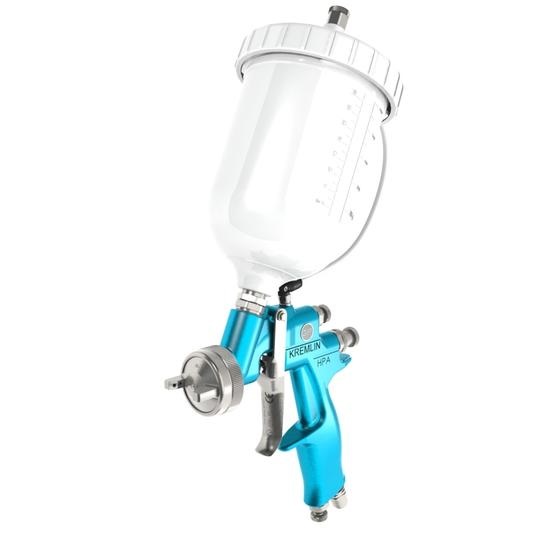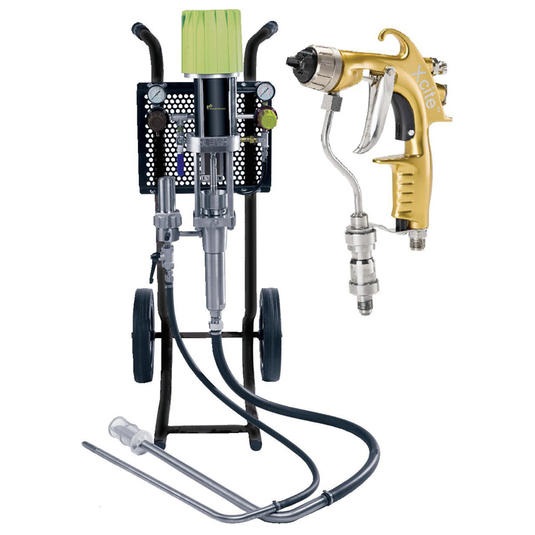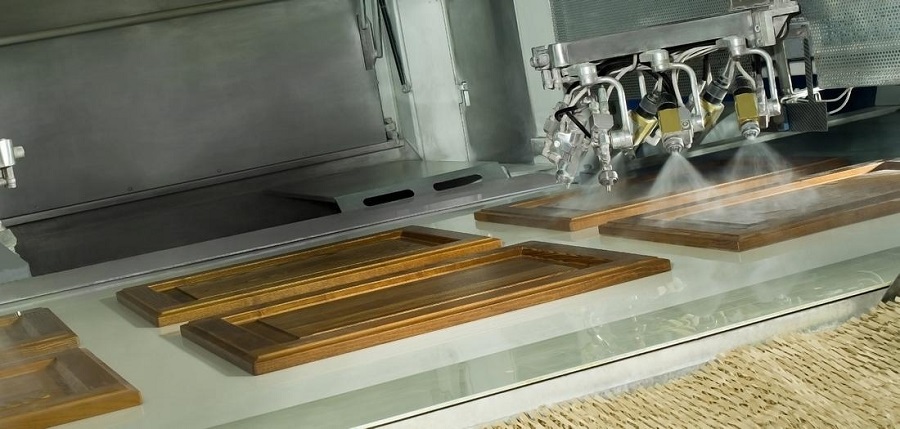If the paint to be applied is viscous the first thought is to dilute it so that it can be applied. This is not a bad idea. There are varnishes and paints that, if not properly thinned before application, will produce a film that looks like orange peel. But there is another type of varnish where thinning is not the solution. These are thixotropic products which have especially high viscosity. It can be applied vertically (sides of furniture, doors, windows, fences, gazebos) without appearing leaking lake. By dilution they lose this property. In addition, the addition of solvent will reduce the solids content (solid body) and the coating will be thin and poor. The bottom line is that they should be used as they are with spray guns or special pumps for such products. Let's see what ways of spraying varnishes are.
I have chosen to present this to you on different levels of difficulty of the machines. The point is that you don't need to be in a factory to be able to do a quality varnish application on your product. I have seen many times how pieces of furniture or other wood items, done very well, are ruined when the lacquer is finally applied. What I'm saying is that you can have a high-performance spray gun even if you have a workshop where you work alone. There are machines for all levels and I will show you 3 of the possibilities.
1. Vascous material spray solutions for workshops, when application is done occasionally, not in a continuous stream.
Viscous materials need pressure or a larger nozzle to be applied. If spray pumps are used this pressure is provided. If the use of viscous products is occasional, however, the investment in a pump is not cost-effective. The simplest solution in this case is to use spray guns with large nozzles of 2.8 or 3. These allow the material to come out of the gun when the air pressure is 4.5-5 atm. Using higher pressure compressed air is not a solution because it leads to losses and poor film quality.
The Sames Kremlin they found an ingenious solution to the problem. They combined the technology of free-fall material application with pressure. That is, they created an overpressure in an ordinary barrel gun to push the lacquer out of the gun.
At first glance it seems the same as increasing pressure which I just said is not a solution, but it is not. If the pressure of compressed air were increased, it would create a cloud of fine particles and lead to large losses of material (lots of varnish in the atmosphere). Also, because of the strong jet of air, it would result in a film of clouding.
In pressurized cup gun proposed by Falk Consulting - Sames Kremlin dispenser - an overpressure is built up inside the cup by means of a small hose that introduces compressed air. The overpressure pushes the lake and forces it out through the narrow nozzle and the compressed air at the usual pressure of 4.5-5 atm turns it into fine particles. These will form a thick film, without orange peel and uncolored.

It is a very suitable solution for those who use viscous materials (e.g. exterior waterborne varnishes) at a workshop level. The result will be very good value for money.
2. Spraying of viscous products in constant production.
Falk Consulting solutions in this case are airmix pump Sames Kremlin with high compression ratio. A minimum pressure of 70 barr is required to apply a viscous material. For pumps this means a compression ratio of min 15:1.
The principle is as follows: the highly viscous product is pushed through a very small nozzle, which leads to pre-atomization. The finer this pre-atomization, the better the film will look in the end.

Spraying can also be done with airless or normal systems, but airmix is recommended for its advantages. Airmix is a Sames Kremlin brand application system which combines the qualities of the other two systems. Unlike airless, the airmix system has an adjustable nozzle radius which allows for a significant reduction in waste. The system is very suitable for application on narrow surfaces such as window frames.
With airless, the radius is changed only by changing the nozzle. This system is suitable for application on large surfaces, where the risk of loss is low and productivity is important. In our company the airless system is little used (approx.10% of the total) because of the specific production (furniture, narrow elements, windows, etc).
3. Application with automatic lines and spray robots
It is the way application is done in factories where production volume is very high. Spraying is part of a finishing line where the object goes in finished in white and comes out ready to be packaged.
The principle remains the same as with pumps, i.e. you need a system that can "push" the viscous sludge. It's all about the compression ratio and the smallest possible nozzles for the finest spray. Airmix guns are generally used and only when large areas are involved are airless guns used.
In the case of finishing lines, it is not just about the guns but about the configuration of the entire line. Parameters such as the size of the objects, type of finishing materials, drying time, viscosity, etc. are taken into account. The guns are mounted on automatic arms (robots) that perform rotation, translation or movements that reproduce the shape of the object (anthropomorphic robots). Finishing lines are specific to each manufacturer and are practically made to order.

In conclusion, regardless of the size of the production, it is important to know that a film looks better the more finely divided the material being applied (the nozzle is smaller). The size of the nozzle is inversely proportional to the pressure applied and the more viscous the product, the higher the pressure must be.




































Add comment